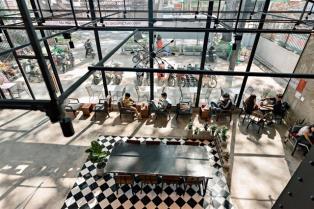At the annual general meeting of the Viet Nam National Petroleum Group (Petrolimex) this year, its management said the corporation plans to enter the retail sector by opening convenience stores.

At the annual general meeting of the Viet Nam National Petroleum Group (Petrolimex) this year, its management said the corporation plans to enter the retail sector by opening convenience stores.
Top executives were confident of the ventures success since the company has a large network of 5,200 petrol stations across the nation where the stores could be opened.
When asked how the company plans to fund the chain, they said while huge investments would be required the company hopes to receive support from its strategic partner, Japanese company JX Nippon Oil & Energy, which owns an 8 per cent stake in Petrolimex.
PetroVietnam Oil Corporation (PV Oil) too has been considering entering the convenience stores segment for the last two years.
The companys managing board has already done a feasibility study on integrating convenience stores into its existing petroleum retail system with 600 outlets.
Why are fuel retailers queuing up to enter a sector dominated by many local and foreign giants such as Saigon Co.op, Vingroup, Circle K, Bs Mart, Mini Stop and 7-Eleven?
The answer might lie in the retail markets huge potential and the fact that fuel businesses have nationwide networks that could be tapped at a moments notice.
Viet Nam has a population of 93.7 million, with 69 per cent of it being between the ages of 18 and 50, and a rapid increase in household spending of 10.5 per cent a year to reach US$714 a month by next year.
According to Deloitte Vietnam, the retail market size was $142 billion in 2018 and will rise to $180 billion by 2020.
But coverage by modern channels remains modest at 25 per cent of retail sales, compared to 33 per cent in the Philippines, 34 per cent in Thailand, 60 per cent in Malaysia, and 90 per cent in Singapore.
Convenience stores make up only 10 per cent of the retail market, half the rate in neighbouring economies. Every 54,400 residents in Viet Nam have one convenience store, while the ratio is one to 2,100 in South Korea and one to 2,900 in China.
Global data also shows that convenience stores and other non-fuel services like vehicle maintenance, repair services, dining malls, and banks account for 50 per cent of petrol stations profits.
But the oil companies would face huge challenges in an intensely competitive retail market, analysts warned.
Foreign convenience store chains now have a clear understanding of Vietnamese consumer tastes and habits, they said.
Petrolimex executives have said they will do careful studies to identify petrol stations that are most suitable for launching convenience retail services.
PV Oil said logistics costs are very high for convenience stores, and so it plans to tie up with an experienced partner instead of entering on its own.
Growing beer industry
Viet Nam is the holy grail for beer companies.
The market has been growing at 300 per cent a year since 2002, and annual per capita consumption now is 41 litres.
The country leads Southeast Asia and is the third-largest market in the Asia-Pacific behind only China and Japan.
The market is expected to grow from four billion litres in 2017 to 4.6 billion litres by 2025 and 5.6 billion litres by 2035.
Breweries make an annual profit of US$1 billion.
A recent study by a market research firm forecast sales of $7.7 billion this year and estimated annual growth of 5.6 per cent in 2019-23, meaning Vietnamese will pay $9.6 billion to drink beer in 2023.
The market is now dominated by four large companies, Sabeco, Heineken, Habeco and Carlsberg, which account for over 90 per cent of sales. Sabeco and Heineken account for more than 60 per cent.
The remaining 10 per cent is made of local brands and foreign names like Sapporo and Budweiser.
The market is almost entirely in foreign hands now. In December 2017 Thai Beverage Public Company Limited (ThaiBev) acquired a 53.59 per cent stake in the Saigon beer-Alcohol-Beverage Corporation or Sabeco, Viet Nams leading brewery, from the Ministry of Industry and Trade for $4.78 billion.
The deal has not only helped Thaibev exploit the lucrative market but also increase its market share in Southeast Asia from 23 per cent before the acquisition to 26 per cent.
The Netherlands-based Heineken, which entered Viet Nam in 1991, operates two companies, the wholly-owned Asia Pacific Breweries and Vietnam Brewery, in which it has a 60 per cent stake.
Its major brands including Heineken, Tiger, Larue, and Amstel. It had almost 22 per cent of the beer market in 2017 and 23 per cent in the first eight months of this year.
Heineken, which positions itself as a brewer of high-end beers, has increased its annual output by 14 per cent since 2012, producing 1.1 billion litres last.
Danish brewer Carlsberg acquired the local Hue Brewery in 2011 and increased its stake in Habeco, Vietnams third-largest beer maker from 17.51 percent to 61.79 per cent last year.
Sapporo is a wholly-owned subsidiary of Japans Sapporo International Inc.
The presence of major global players in the Vietnamese market has helped strongly improve the efficiency of the industry, making beer company shares increasingly attractive to investors.
At Sabeco for instance, Thaibev implemented various plans to revamp the company soon after it took over the management, resulting in excellent outcomes.
The restructuring was a major reason for the brewery achieving a 9 per cent increase in turnover in the first half of this year to VND18.4 trillion and a 15.2 per cent increase in after-tax profit to VND2.82 trillion.
Sabeco targets full-year turnover of around 39 trillion and profit of VND4.7 trillion, 8.3 and 6.8 per cent higher than last year.
Sabeco, listed on the HCM Stock Exchange, will pay out VND960 billion ($42.24 million) to its shareholders as dividends for 2018, with the rate increasing from the planned 35 per cent to 50 per cent.
Though Saigon Beer Western Joint Stock Company is not a giant producer, its results are very impressive. In the first half of this year its revenues were VND514.6 billion, up 9 per cent from the same period last year.
Its gross profit margin was over 20 per cent, significantly up from the first half of last year, and its after-tax profit was VMD84.3 billion, up 27.4 per cent.
Sabeco and Saigon Beer Western Joint Stock Company (WSB) have a common feature that investors find attractive: both have always been ready to pay dividends in cash.
But the liquidity of brewery shares is often low.
Analysts said the nature of beer companies in Viet Nam is to have a concentrated shareholding structure with the state and major investors holding a majority of the shares.
Besides, most opt to pay dividends in cash and so shareholders, happy with the high dividends, do not want to sell their shares. This means trading is usually limited, they said.
In the last 10 sessions an average of 15,000 shares of SAB were traded, 2,450 of Habeco and 3,700 of WSB. — VNS





